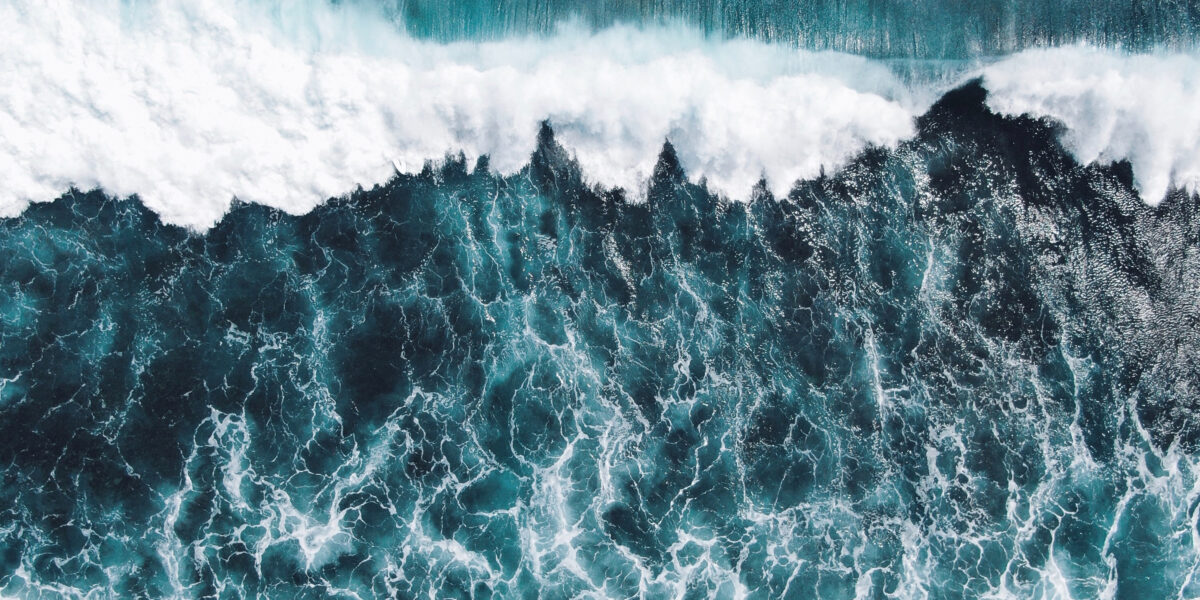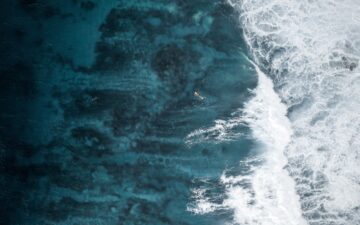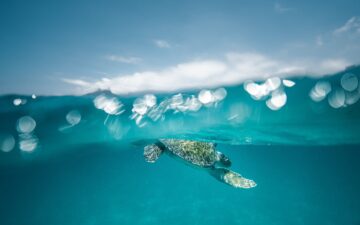1. Introduction
2. What is the Blue Economy?
3. Economic Impact
4. Aquaculture and Fisheries
5. Tourism, Cruises, and Recreational Fishing
6. Technology in the Blue Economy
7. Blue Growth
8. National Government and International Organizational Action
Click below to learn more about our sustainable blue economy approach:
1. Introduction
Empires were completely based on the exploitation of natural resources, as well as trade in consumer goods (textiles, spices, chinaware), and (sadly) slaves and were dependent on the ocean for transport. Even the industrial revolution was powered by oil from the ocean, for without spermaceti oil to lubricate the machines, the scale of production could not have changed. Investors, speculators, and the nascent insurance industry (Lloyd’s of London) were all built from participation in the international ocean trade in spices, whale oil, and precious metals.
Thus, investing in the ocean economy is nearly as old as the ocean economy itself. So why are we talking as if there’s something new? Why are we inventing the phrase “the blue economy?” Why do we think there is a new growth opportunity from a “blue economy?”
The (new) Blue Economy refers to economic activities that are both based in, and which are actively good for the ocean, though definitions vary. While the concept of the Blue Economy continues to change and adapt, economic development in the ocean and coastal communities can be designed to serve as a basis for sustainable development around the world.
At the core of the new Blue Economy concept is the de-coupling of socioeconomic development from environmental degradation… a subset of the entire ocean economy that has regenerative and restorative activities that lead to enhanced human health and well-being, including food security and creation of sustainable livelihoods.
Mark J. Spalding | February, 2016
BACK TO TOP
2. What is the Blue Economy?
Spalding, M. J. (2021, May 26) Investing in the New Blue Economy. The Ocean Foundation. Retrieved from: https://youtu.be/ZsVxTrluCvI
The Ocean Foundation is a partner and advisor of Rockefeller Capital Management, helping identify public companies whose products and services meet the needs of a healthy human relationship with the ocean. In 2020, The Ocean Foundation collaborated with Credit Suisse and Rockefeller Asset Management (RAM), a division of Rockefeller Capital Management, on the launch of the Ocean Engagement Strategy to help invest in the Blue Economy. TOF President Mark J. Spalding discusses this partnership and investing in a sustainable blue economy in a recent 2021 webinar.
Wenhai L., Cusack C., Baker M., Tao W., Mingbao C., Paige K., Xiaofan Z., Levin L., Escobar E., Amon D., Yue Y., Reitz A., Neves A.A.S., O’Rourke E., Mannarini G., Pearlman J., Tinker J., Horsburgh K.J., Lehodey P., Pouliquen S., Dale T., Peng Z. and Yufeng Y. (2019, June 07). Successful Blue Economy Examples With an Emphasis on International Perspectives. Frontiers in Marine Science 6 (261). Retrieved from: https://doi.org/10.3389/fmars.2019.00261
The Blue Economy serves as a framework and policy for sustainable marine economic activities as well as new marine-based technologies. This paper provides a comprehensive overview as well as theoretical and real-world case studies representing diverse world regions to provide a consensus of the Blue Economy as a whole.
Banos Ruiz, I. (2018, July 03). Blue Economy: Not just for Fish. Deutsche Welle. Retrieved from: https://p.dw.com/p/2tnP6.
In a brief introduction to the Blue Economy, Deutsche Welle Germany’s international broadcaster provides a straightforward overview of the multifaceted Blue Economy. Discussing threats such as overfishing, climate change, and plastic pollution, the author argues that what is bad for the ocean is bad for humankind and there remain many areas in need of continued cooperation to protect the ocean’s vast economic wealth.
Keen, M., Schwarz, A. M., Wini-Simeon, L. (February 2018). Towards Defining the Blue Economy: Practical Lessons from Pacific Ocean Governance. Marine Policy. Vol. 88 pg. 333 – pg. 341. Retrieved from: http://dx.doi.org/10.1016/j.marpol.2017.03.002
The authors developed a conceptual framework to address the variety of terms associated with the Blue Economy. This framework is demonstrated in a case study of three fisheries in the Solomon Islands: small-scale, national urban markets, and international industry development through onshore tuna processing. On the ground level, there remain challenges ranging from local support, gender equality and local political constituencies that all affect the sustainability of the Blue Economy.
World Wildlife Fund (2018) Principles for a Sustainable Blue Economy Briefing. The World Wildlife Fund. Retrieved from: https://wwf.panda.org/our_work/oceans/publications/?247858/Principles-for-a-Sustainable-Blue-Economy
The World Wildlife Fund’s Principles for a Sustainable Blue Economy aims to briefly outline the concept of the Blue Economy to ensure the economic development of the ocean contributes to true prosperity. The article argues that the sustainable Blue Economy should be governed by public and private processes that are inclusive, well-informed, adaptive, accountable, transparent, holistic, and proactive. To accomplish these goals public and private actors must set measurable goals, assess and communicate their performance, provide adequate rules and incentives, effectively govern the use of marine space, develop standards, understand marine pollution usually originates on land, and actively cooperate to promote change.
Grimm, K. and J. Fitzsimmons. (2017, October 6) Research and Recommendations on Communication about the Blue Economy. Spitfire. PDF.
Spitfire created a landscape analysis on communication concerning the Blue Economy for the 2017 Mid-Atlantic Blue Ocean Economy 2030 Forum. The analysis revealed a leading problem remains a lack of definition and knowledge in both industries and among the general public and policymakers. Among the dozen additional recommendations presented a common theme on the need for strategic messaging and active engagement.
Food and Agriculture Organization of the United Nations. (2017, May 3). Blue Growth Charter in Cabo Verde. United Nations. Retrieved from: https://www.youtube.com/watch?v=cmw4kvfUnZI
The United Nations Food and Agriculture Organization supports Small Island Developing States through a number of projects around the world, including the Blue Growth Charter. Cape Verde was chosen as the pilot project of the Blue Growth Charter to promote policies and investments related to sustainable ocean development. The video highlights the various aspects of the Blue Economy including the ramifications for the local population not often presented in large scale descriptions of the Blue Economy.
Spalding, M. J. (2016, February). The New Blue Economy: the Future of Sustainability. Journal of Ocean and Coastal Economics. Retrieved from: http://dx.doi.org/10.15351/2373-8456.1052
The new Blue Economy is a term developed to explain activities that promote a positive relationship between human endeavors, economic activity, and conservation efforts.
UN Environment Programme Finance Initiative. (2021, March). Turning the Tide: How to finance a sustainable ocean recovery: A practical guide for financial institutions to lead a sustainable ocean recovery. Downloadable here on this website.
This seminal guidance provided by the UN Environment Programme Finance Initiative is a market-first practical toolkit for financial institutions to pivot their activities towards financing a sustainable blue economy. Designed for banks, insurers and investors, the guidance outlines how to avoid and mitigate environmental and social risks and impacts, as well as highlighting opportunities, when providing capital to companies or projects within the blue economy. Five key ocean sectors are explored, chosen for their established connection with private finance: seafood, shipping, ports, coastal and marine tourism and marine renewable energy, notably offshore wind.
BACK TO TOP
3. Economic Impact
Asian Development Bank / International Finance Corporation in collaboration with the International Capital Market Association (ICMA), United National Environment Programme Finance Initiative (UNEP FI), and United Nations Global Compact (UNGC) (2023, September). Bonds to Finance the Sustainable Blue Economy: A Practitioner’s Guide. https://www.icmagroup.org/assets/documents/Sustainable-finance/Bonds-to-Finance-the-Sustainable-Blue-Economy-a-Practitioners-Guide-September-2023.pdf
New guidance on blue bonds to help unlock finance for a sustainable ocean economy | The International Capital Market Association (ICMA) together with the International Finance Corporation (IFC) – a member of the World Bank Group, United Nations Global Compact, the Asian Development Bank and UNEP FI have developed a global practitioner’s guide for bonds to finance the sustainable blue economy. This voluntary guidance provides market participants with clear criteria, practices, and examples for “blue bond” lending and issuances. Gathering input from the financial markets, ocean industry and global institutions, it provides information on the key components involved in launching a credible “blue bond,” how to evaluate the environmental impact of “blue bond” investments; and the steps needed to facilitate transactions that preserve the integrity of the market.
Spalding, M. J. (2021, December 17). Measuring Sustainable Ocean Economy Investing. Wilson Center. https://www.wilsoncenter.org/article/measuring-sustainable-ocean-economy-investing
Investing in a sustainable ocean economy is not just about driving superior risk-adjusted returns, but also about providing for the protection and restoration of more intangible blue resources. We propose seven major categories of sustainable blue economy investments, which are at varying stages and can accommodate public or private investment, debt financing, philanthropy, and other sources of funds. These seven categories are: coastal economic and social resilience, improving ocean transport, ocean renewable energy, ocean-sources food investment, ocean biotechnology, cleaning up the ocean, and anticipated next-generation ocean activities. Further, investment advisors and asset owners can support investment in the blue economy, including by engaging companies and pulling them toward better behavior, products, and services.
Metroeconomica, The Ocean Foundation, and WRI Mexico. (2021, January 15). Economic Valuation of Reef Ecosystems in the MAR Region and the Goods and Services they Provide, Final Report. Inter-American Development Bank. PDF.
Mesoamerican Barrier Reef System (MBRS or MAR) is the largest reef ecosystem in America and the second-largest in the world. The study considered provisioning services, cultural services, and regulating services provided by reef ecosystems in the MAR region, and found that tourism and recreation contributed 4,092 million USD in the Mesoamerican Region, with fisheries contributing an additional 615 million USD. The annual benefits of shoreline protection equated to 322.83-440.71 million USD. This report is the culmination of four online working sessions in a January 2021 workshop with over 100 attendees representing four MAR countries: Mexico, Belize, Guatemala, and Honduras. The Executive Summary can be found here, and an infographic can be found below:
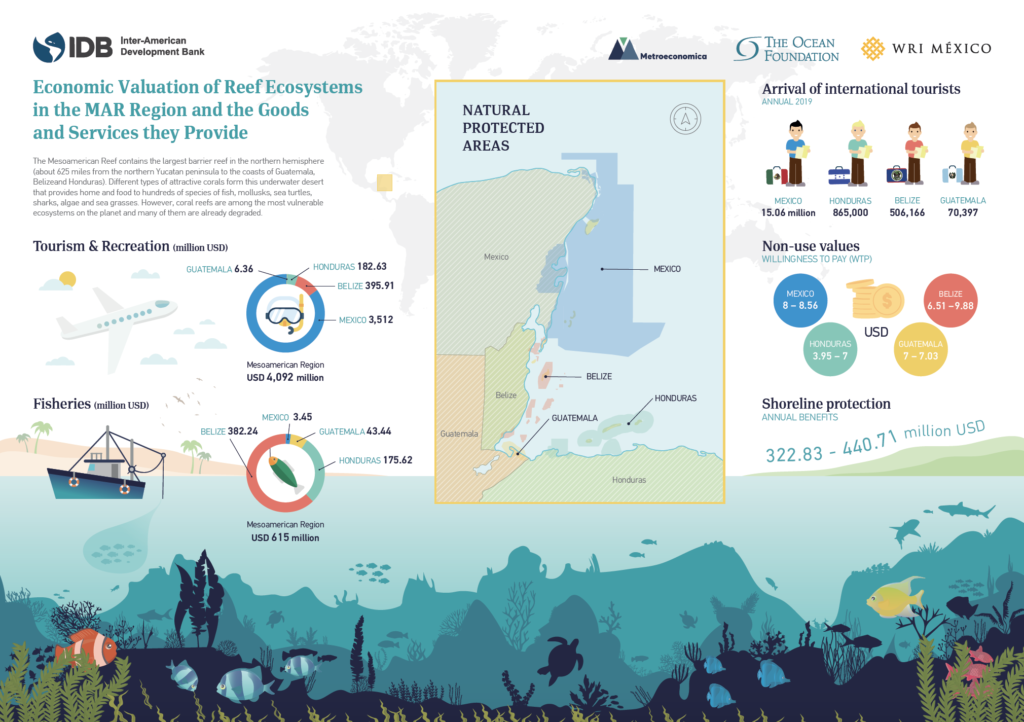
Voyer, M., van Leeuwen, J. (2019, August). “Social License to Operate” in the Blue Economy. Resources Policy. (62) 102-113. Retrieved from: https://www.sciencedirect.com/
The Blue Economy as an ocean-based economic model calls for discussion of the role of a social license to operate. The article argues that social license, through the approval by local communities and stakeholders, affects a project’s profitability relative to the Blue Economy.
Blue Economy Summit. (2019).Towards Sustainable Blue Economies in the Caribbean. Blue Economy Summit, Roatan, Honduras. PDF.
Initiatives all across the Caribbean have begun transitioning toward inclusive, cross-sectoral and sustainable production including both industry planning and governance. The report includes two case studies of efforts in Grenada and the Bahamas and resources for more information on initiatives focused on sustainable development in the Wider Caribbean region.
Attri, V. N. (2018 November 27). New and Emerging Investment Opportunities Under Sustainable Blue Economy. Business Forum, Sustainable Blue Economy Conference. Nairobi, Kenya. PDF.
The Indian Ocean Region presents significant investment opportunities for the sustainable Blue Economy. Investment can be supported by showcasing the established link between corporate sustainability performance and financial performance. The best results for promoting sustainable investment in the Indian Ocean will come with the involvement of governments, the private sector, and multilateral organizations.
Mwanza, K. (2018, November 26). African Fishing Communities Face “extinction” as Blue Economy Grows: Experts.” Thomas Reuters Foundation. Retrieved from: https://www.reuters.com/article/us-africa-oceans-blueeconomy/african-fishing-communities-face-extinction-as-blue-economy-grows-experts-idUSKCN1NV2HI
There is a risk that Blue Economy development programs can marginalize fishing communities when countries prioritize tourism, industrial fishing, and exploration revenue. This short article showcases the problems of increased development without consideration for sustainability.
Caribank. (2018, May 31). Seminar: Financing the Blue Economy- A Caribbean Development Opportunity. Caribbean Development Bank. Retrieved from: https://www.youtube.com/watch?v=2O1Nf4duVRU
The Caribbean Development Bank hosted a seminar at their 2018 Annual Meeting on “Financing the Blue Economy- A Caribbean Development Opportunity.” The seminar discusses both internal and international mechanisms used to fund industry, improve the system for blue economy initiatives, and improve investment opportunities within the Blue Economy.
Sarker, S., Bhuyan, Md., Rahman, M., Md. Islam, Hossain, Md., Basak, S. Islam, M. (2018, May 1). From Science to Action: Exploring the Potentials of Blue Economy for Enhancing Economic Sustainability in Bangladesh. Ocean and Coastal Management. (157) 180-192. Retrieved from: https://www.sciencedirect.com/science/article/pii
Bangladesh is examined as a case study of the potential of the Blue Economy, where there is significant potential, yet many other challenges remain, particularly in trade and commerce related to the sea and coast. The report finds that Blue Growth, which the article defines as increased economic activity in the ocean, must not sacrifice environmental sustainability for economic profit as seen in Bangladesh.
The Declaration of the Sustainable Blue Economy Finance Principles. (2018 January 15). The European Commission. Retrieved from: https://ec.europa.eu/maritimeaffairs/sites/maritimeaffairs/files/ declaration-sustainable-blue-economy-finance-principles_en.pdf
Representatives of the financial services sector and non-profit groups including the European Commission, European Investment Bank, World Wide Fund for Nature, and The Prince of Wales’s International Sustainability Unit created a framework Blue Economy Investment Principles. The fourteen principles include being transparent, risk-aware, impactful, and science-based when developing the Blue Economy. Their goal is to support the development of and provide a framework for a sustainable ocean-based economy.
Blue Economy Caribbean. (2018). Action Items. BEC, New Energy Events. Retrieved from: http://newenergyevents.com/bec/wp-content/uploads/sites/29/2018/11/BEC_5-Action-Items.pdf
An infographic that demonstrates the steps need to continue developing the blue economy in the Caribbean. These include leadership, coordination, public advocacy, demand-driven, and valuation.
Blue Economy Caribbean (2018). Caribbean Blue Economy: An OECS Perspective. Presentation. BEC, New Energy Events. Retrieved from: http://newenergyevents.com/blue-economy-caribbean/wp-content/uploads/sites/25/2018/11/BEC_Showcase_OECS.pdf
The Organisation of Eastern Caribbean States (OECS) presented on the Blue Economy in the Caribbean including an overview of economic significance and major players in the region. Their vision focuses on a healthy and richly biodiverse Eastern Caribbean marine environment sustainably managed while being conscious at promoting socio-economic development for peoples of the region.
Government of Anguilla. (2018) Monetising Anguilla’s 200 Mile EFZ Presented at the Caribbean Blue Economy Conference, Miami. PDF.
Covering over 85,000 sq. km, Anguilla’s EFZ is one of the largest in the Caribbean. The presentation provides a general outline of the implementation of an offshore fisheries license regime and examples of past benefits for island nations. Steps to create a license include collecting and analysis fisheries data, creating a legal framework to issue offshore licenses and provide monitoring and surveillance.
Hansen, E., Holthus, P., Allen, C., Bae, J., Goh, J., Mihailescu, C., and C. Pedregon. (2018). Ocean/Maritime Clusters: Leadership and Collaboration for Ocean Sustainable Development and Implementing the Sustainable Development Goals. World Ocean Council. PDF.
Ocean/Maritime Clusters are geographic concentrations of related maritime industries that share common markets and operate near to one another through multiple networks. These clusters can play a vital role in advancing ocean sustainable development by combining innovation, competitiveness-productivity-profit and environmental impact.
Humphrey, K. (2018). Blue Economy Barbados, Ministry of Maritime Affairs and the Blue Economy. PDF.
Barbados’s Blue Economy Framework is made up of three pillars: transportation and logistics, housing and hospitality, and health and nutrition. Their goal is to preserve the environment, become 100% renewable energy, ban plastics, and improve marine management policies.
Parsan, N. and A. Friday. (2018). Master Planning for Blue Growth in the Caribbean: A Case Study from Grenada. Presentation at the Blue Economy Caribbean. PDF.
Grenada’s economy was devastated by Hurricane Ivan in 2004 and subsequently felt the effects of the Financial Crisis leading to a 40% unemployment rate. This presented an opportunity to develop Blue Growth for economic renewal. Identifying nine clusters of activity the process was funded by the World Bank with the goal for St. George to become the first climate-smart capital city. More information on Grenada’s Blue Growth Master plan can also be found here.
Ram, J. (2018) The Blue Economy: A Caribbean Development Opportunity. Caribbean Development Bank. PDF.
Director of Economics at the Caribbean Development Bank presented at the 2018 Blue Economy Caribbean on the opportunities for investors in the Caribbean region. The presentation includes newer models of investment such as Blended Finance, Blue Bonds, Recoverable Grants, Debt-for-Nature Swaps, and directly address private investing in the Blue Economy.
Klinger, D., Eikeset, A. M., Davíðsdóttir, B., Winter, A. M., Watson, J. (2017, October 21). The Mechanics of Blue Growth: Management of Oceanic Natural Resource Use with Multiple, Interacting Actors. Marine Policy (87). 356-362.
Blue Growth relies on the integrated management of multiple economic sectors to optimally utilize the ocean’s natural resources. Because of the dynamic nature of the ocean there both collaboration as well as hostility, between tourism and offshore energy production, and between various localities and countries vying for finite resources.
Spalding, M. J. (2015 October 30). Looking at the Small Details. A blog about a summit entited “The Oceans in National Income Accounts: Seeking Consensus on Definitions and Standards”. The Ocean Foundation. Accessed July 22, 2019. https://oceanfdn.org/looking-at-the-small-details/
The (new) blue economy is not about new emerging technology, but economic activities that are sustainable vs. unsustainable. However, industry classification codes lack the distinction of sustainable practices, as determined by “The Oceans National Income Account” summit in Asilomar, California. TOF President Mark Spalding’s blog post conclusions classification codes provide valuable data metrics necessary for analyzing change over time and for informing policy.
National Ocean Economics Program. (2015). Market Data. Middlebury Institute of International Studies at Monterey: Center for the Blue Economy. Retrieved from: http://www.oceaneconomics.org/market/coastal/
Middlebury’s Center for the Blue Economy provides a number of statistics and economic values for industries based on market transactions in the Ocean and coastal economies. Divided by year, state, county, industry sectors, as well as shoreline regions and values. Their quantitative data is highly beneficial in demonstrating the impact of ocean and coastal industries on the global economy.
Spalding, M. J. (2015). Ocean Sustainability and Global Resource Management. A blog on the “Ocean Sustainability Science Symposium”. The Ocean Foundation. Accessed July 22, 2019. https://oceanfdn.org/blog/ocean-sustainability-and-global-resource-management
From plastics to Ocean Acidification humans are responsible for the current state of ruin and people must continue to work to improve the state of the world’s ocean. TOF President Mark Spalding’s blog post encourages actions that do no harm, create opportunities for ocean restoration, and take the pressure off the ocean as a shared resource.
The Economist Intelligence Unit. (2015). The Blue Economy: Growth, Opportunity, and a Sustainable Ocean Economy. The Economist: briefing paper for the World Ocean Summit 2015. Retrieved from: https://www.woi.economist.com/content/uploads/2018/ 04/m1_EIU_The-Blue-Economy_2015.pdf
Initially prepared for World Ocean Summit 2015, The Economist’s Intelligence Unit looks into the emergence of the blue economy, the balance of economy and conservation, and finally potential investment strategies. This paper provides a broad overview of ocean-based economic activity and offers discussion points on the future of economy activity involving ocean-focused industries.
BenDor, T., Lester, W., Livengood, A., Davis, A. and L. Yonavjak. (2015). Estimating the Size and Impact of the Ecological Restoration Economy. Public Library of Science 10(6): e0128339. Retrieved from: https://journals.plos.org/plosone/article?id=10.1371/journal.pone.0128339
Research shows that domestic ecological restoration, as a sector, generates roughly $9.5 billion in sales annually and 221,000 jobs. Ecological restoration can be broadly referred to as economic activity that aids in returning ecosystems to a state of improved health and fill functions. This case study was the first to show the statistically significant benefits of ecological restoration on the national level.
Kildow, J., Colgan, C., Scorse, J., Johnston, P., and M. Nichols. (2014). State of the U.S. Ocean and Coastal Economies 2014. Center for the Blue Economy: Middlebury Institute of International Studies at Monterey: National Ocean Economics Program. Retrieved from: http://cbe.miis.edu/noep_publications/1
The Monterey Institute of International Studies’ Center for the Blue Economy provides an in-depth look into economic activities, demographics, cargo value, natural resource value and production, government expenditures in the United States related to the ocean and coastal industries. The report publishes numerous tables and analytics that provide a comprehensive statistical analysis of the ocean economy.
Conathan, M. and K. Kroh. (2012 June). The Foundations of a Blue Economy: CAP Launches New Project Promoting Sustainable Ocean Industries. Center for American Progress. Retrieved from: https://www.americanprogress.org/issues/green/report/2012/06/ 27/11794/thefoundations-of-a-blue-economy/
The Center for American Progress produced a brief on their Blue Economy project that focuses on the nexus of the environment, economy, and industries that depend on and coexist with the ocean, coast, and Great Lakes. Their report highlights the need for a greater study of economic impact and values that are not always evident in traditional data analysis. These include economic benefits that require a clean and healthy ocean environment, such as the commercial value of waterfront property or the consumer utility gained by walking on the beach.
BACK TO TOP
4. Aquaculture and Fisheries
Below you will find a holistic view of aquaculture and fisheries through the lens of a comprehensive Blue Economy, for a more detailed study please see The Ocean Foundation’s resource pages on Sustainable Aquaculture and Tools and Strategies for Effective Fisheries Management respectively.
Bailey, K. M. (2018). Fishing Lessons: Artisanal Fisheries and the Future of our Oceans. Chicago and London: The University of Chicago Press.
Small-scale fisheries play a major role in employment globally, they provide one-half to two-thirds of the global fish-food catch but engage 80-90% of fish workers worldwide, half of whom are women. But problems persist. As industrialization grows it becomes harder for small-scale fishermen to maintain fishing rights, especially as areas become overfished. Using personal stories from fishermen around the world, Bailey comments on the global fishing industry and the relationship between small-scale fisheries and the environment.
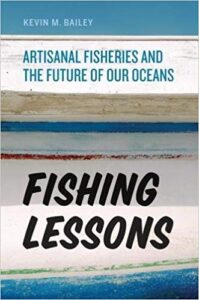
Food and Agriculture Organization of the United Nations. (2018). The State of World Fisheries and Aquaculture: Meeting the Sustainable Development Goals. Rome. PDF.
The United Nations 2018 report on the world’s fisheries provided a detailed data-driven investigation necessary to manage aquatic resources in the Blue Economy. The report highlights major challenges including continued sustainability, an integrated multisectoral approach, addressing biosecurity, and accurate statistical reporting. Full report available here.
Allison, E. H. (2011). Aquaculture, Fisheries, Poverty and Food Security. Commissioned for OECD. Penang: WorldFish Centre. PDF.
The WorldFish Center’s report suggests sustainable policies in fisheries and aquaculture can provide significant gains in food security and lower poverty rates in developing countries. Strategic policy must also be implemented along with sustainable practices to be effective long-term. Efficient fishery and aquaculture practices benefit many communities as long as they are modified to individual areas and countries. This supports the idea that sustainable practices have profound impacts on the economy as a whole and provides guidance for fishery development in the Blue Economy.
Mills, D. J., Westlund, L., de Graaf, G., Kura, Y., Willman, R. and K. Kelleher. (2011). Underreported and undervalued: Small-scale fisheries in the developing world in R. Pomeroy and N. L. Andrew (eds.), Managing Small Scale Fisheries: Frameworks and Approaches. UK: CABI. Retrieved from: https://www.cabi.org/bookshop/book/9781845936075/
Through “snapshot” case studies Mills looks at the socio-economic functions of fisheries in developing countries. As a whole, small-scale fisheries are undervalued at the national level particularly concerning fisheries’ impact on food security, poverty alleviation and livelihood provision, as well as issues with local-level fisheries governance in many developing countries. Fisheries are one of the largest sectors of the ocean economy and this holistic review serves to encourage realistic and sustainable development.
BACK TO TOP
5. Tourism, Cruises, and Recreational Fishing
Conathan, M. (2011). Fish on Fridays: Twelve Million Lines in the Water. Center for American Progress. Retrieved from: https://www.americanprogress.org/issues/green/news/2011/ 07/01/9922/fishon-fridays-twelve-million-lines-in-the-water/
The Center for American Progress examines the finding that recreational fishing, involving over 12 million Americans annually, threatens many fish species in disproportionate numbers compared to commercial fishing. The best practice to limit environmental impact and overfishing includes following license laws and to practice safe catch and release. This article’s analysis of best practices helps promote realistic sustainable management of the Blue Economy.
Zappino, V. (2005 June). Caribbean Tourism and Development: An Overview [Final Report]. Discussion Paper No. 65. European Centre for Development Policy Management. Retrieved from: http://ecdpm.org/wpcontent/uploads/2013/11/DP-65-Caribbean-Tourism-Industry-Development-2005.pdf
Tourism in the Caribbean is one of the most important industries in the region, attracting millions of tourists every year via resorts and as a cruise destination. In an economic study pertinent to development in the Blue Economy, Zappino looks at the environmental impact of tourism and analyzes sustainable tourism initiatives in the region. He recommends further implementation of regional guidelines for sustainable practices that benefit the local community necessary for Blue Economy development.
BACK TO TOP
6. Technology in the Blue Economy
U.S. Department of Energy.(2018 April). Powering the Blue Economy Report. U. S. Department of Energy, Office of Energy Efficiency and Renewable Energy. https://www.energy.gov/eere/water/downloads/powering-blue-economy-report
Through a high-level analysis of potential market opportunities, the U.S. Department of Energy looks at the ability for new capabilities and economic development in marine energy. The report looks into power for offshore and nearshore industries including the powering of desalination, coastal resilience and disaster recovery, offshore aquaculture, and power systems for isolated communities. Additional information on topics of marine power including marine algae, desalination, coastal resiliency and isolated power systems can be found here.
Michel, K. and P. Noble. (2008). Technological Advances in Maritime Transportation. The Bridge 38:2, 33-40.
Michel and Noble discuss the technical advances in major innovations in the maritime commercial shipping industry. The authors stress the need for environmentally friendly practices. Major areas of discussions in the article include current industry practices, ship design, navigation, and successful implementation of emerging technology. Shipping and trade are a major driver of ocean growth and understanding ocean transports is essential for achieving a sustainable Blue Economy.
BACK TO TOP
7. Blue Growth
Soma, K., van den Burg, S., Hoefnagel, E., Stuiver, M., van der Heide, M. (2018 January). Social Innovation- A Future Pathway for Blue Growth? Marine Policy. Vol 87: pg. 363- pg. 370. Retrieved from: https://www.sciencedirect.com/science/article/pii/
Strategic blue growth as proposed by the European Union seeks to attract new technology and ideas that have a low impact on the environment, while also taking into account the social interactions necessary for sustainable practices. In a case study of aquaculture in the Dutch North Sea researchers identified practices that could benefit from innovation while also considered attitudes, promoted collaboration, and the explored long-term effects on the environment. While many challenges still exist, including buy-in from local producers, the article highlights the importance of a social aspect in the blue economy.
Lillebø, A.I., Pita, C., Garcia Rodrigues, J., Ramos, S., Villasante, S. (2017, July) How Can Marine Ecosystem Services Support the Blue Growth Agenda? Marine Policy (81) 132-142. Retrieved from: https://www.sciencedirect.com/science/article/pii/ S0308597X16308107?via%3Dihub
The European Union’s Blue Growth Agenda looks at the marine provisioning of environmental services particularly in areas of aquaculture, blue biotechnology, blue energy and the physical provisioning of the extraction of marine mineral resources and tourism all. These sectors all depend on healthy marine and coastal ecosystems that are only possible through regulation and proper maintenance of environmental services. The authors argue that Blue Growth opportunities require navigating trade-offs between economic, social, and environmental limitations, though development will benefit from additional managing legislation.
Virdin, J. and Patil, P. (eds.). (2016). Toward a Blue Economy: A Promise for Sustainable Growth in the Caribbean. The World Bank. Retrieved from: https://openknowledge.worldbank.org/bitstream/handle/ 10986/25061/Demystifying0t0the0Caribbean0Region.pdf
Designed for policymakers within the Caribbean region, this treatise serves as a comprehensive overview of the concept of the Blue Economy. Caribbean states and territories are intrinsically linked to the natural resources of the Caribbean Sea and understanding and measuring the economic impacts are essential for sustainable or equitable growth. The report serves to be the first step in assessing the true potential of the ocean as an economic space and engine for growth, while also recommending policies to better manage sustainable use of the ocean and sea.
World Wildlife Fund. (2015, April 22). Reviving the Ocean Economy. WWF International Production. Retrieved from: https://www.worldwildlife.org/publications/reviving-the-oceans-economy-the-case-for-action-2015
The ocean is a major contributor to the global economy and action must be taken to ramp up effective conservation of coastal and marine habitats in all countries. The report highlights eight specific actions including, the need to embrace the United Nation’s Sustainable Development Goals, cut emissions to address ocean acidification, effectively manage at least 10 percent of marine areas in every country, understand habitat protection and fisheries management, appropriate international mechanisms for negotiation and collaboration, develop public-private partnerships that consider community well-being, develop transparent and public accounting of ocean benefits, and finally create an international platform to support and share ocean knowledge based on data. Together these actions can revive the ocean economy and leads to ocean restoration.
BACK TO TOP
8. National Government and International Organizational Action
Africa Blue Economy Forum. (June 2019). Africa Blue Economy Forum Concept Note. Blue Jay Communication Ltd., London. PDF.
The second African Blue Economy Form focused on the challenges and opportunities in Africa’s growing ocean economy, the relationship between traditional and emerging industries, and promoting sustainability through the development of a circular economy. A major point addressed was the high level of ocean pollution. Many innovative start-ups have begun to address the issue of ocean pollution, but these routinely lack funding to scale-up industries.
The Commonwealth Blue Charter. (2019). Blue Economy. Retrieved from: https://thecommonwealth.org/blue-economy.
There is a close linkage between the ocean, climate change, and the wellbeing of the people of the commonwealth making it apparent that actions must be taken. The Blue Economy model aims for the improvement of human wellbeing and social equality, while significantly reducing environmental risks and ecological scarcities. This webpage highlights the Blue Charter’s mission to help countries develop an integrated approach to the building of the blue economy.
Sustainable Blue Economy Conference Technical Committee. (2018, December). Sustainable Blue Economy Conference Final Report. Nairobi, Kenya November 26-28, 2018. PDF.
The global Sustainable Blue Economy Conference, held in Nairobi, Kenya, focused on sustainable development that includes the ocean, seas, lakes, and rivers per the 2030 United Nations Agenda. Participants ranged from heads of states and representatives of international organizations to the business sector and community leaders, presented on research and attended forums. The result of the conference was the creation of the Nairobi Statement of Intent on Advancing a Sustainable Blue Economy.
The World Bank. (2018, October 29). Sovereign Blue Bond Issuance: Frequently Asked Questions. The World Bank Group. Retrieved from: https://www.worldbank.org/en/news/feature/2018/10/29/ sovereign-blue-bond-issuance-frequently-asked-questions
A Blue Bond is a debt issued by governments and development banks to raise capital from impact investors to finance marine and ocean-based projects that have positive environmental, economic, and climate benefits. The Republic of Seychelles was the first to issue a Blue Bond, they set up a $3 million Blue Grants Fund and a $12 million Blue Investment Fund to promote sustainable fisheries.
Africa Blue Economy Forum. (2018). Africa Blue Economy Forum 2018 Final Report. Blue Jay Communication Ltd., London. PDF.
The London based forum brought together international experts and government officials to mainstream African countries’ various Blue Economy strategies in the context of the African Union’s Agenda 2063 and the United Nation’s Sustainable Development Goals (SDGs). Topics of discussion included illegal and unregulated fishing, maritime security, ocean governance, energy, trade, tourism, and innovation. The forum ended with a call for action to implement practical sustainable practices.
European Commission (2018). The 2018 Annual Economic Report on E.U. Blue Economy. European Union Maritime Affairs and Fisheries. Retrieved from: https://ec.europa.eu/maritimeaffairs/sites/maritimeaffairs/files/ 2018-annual-economic-report-on-blue-economy_en.pdf
The annual report provides a detailed description of the size and scope of the blue economy concerning the European Union. The goal of the report is to identify and harness the potential of Europe’s seas, coast and ocean for economic growth. The report includes discussions of direct socio-economic impact, recent and emerging sectors, case studies from E.U. member states concerning blue economic activity.
Vreÿ, Francois. (2017 May 28). How African Countries can Harness the Huge Potential of their Oceans. The Conversation. Retrieved from: http://theconversation.com/how-african-countries-can-harness-the-huge-potential-of-their-oceans-77889.
Governance and security issues are necessary for discussions of the Blue Economy by African nations to achieve robust economic benefits. Criminality such as illegal fishing, sea piracy, and armed robbery, smuggling, and illegal migration makes it impossible for countries to realize the potential of their seas, coasts and ocean. In response, many initiatives have been developed including additional cooperation across national boundaries and ensuring national laws are enforced and aligned with the United Nation’s treaty on ocean safety.
World Bank Group and the U.N. Department of Economic and Social Affairs. (2017). The Potential of the Blue Economy: Increasing Long-term Benefits of the Sustainable Use of Marine Resources for Small Island Developing States and Coastal Least Developed Countries. The International Bank for The Construction and Development, The World Bank. Retrieved from: https://openknowledge.worldbank.org/bitstream/handle/ 10986/26843/115545.pdf
There are a number of pathways toward the blue economy all of which depend on both local and national priorities. These are explored through the World Bank’s overview of economic drivers of the Blue Economy in their treatise on coastal least developed countries and small island developing states.
United Nations. (2016). Africa’s Blue Economy: A Policy Handbook. Economic Commission for Africa. Retrieved from: https://www.uneca.org/sites/default/files/PublicationFiles/blue-eco-policy-handbook_eng_1nov.pdf
Thirty-eight of fifty-four African countries are coastal or island states and more than 90 percent of Africa’s imports and exports are conducted by sea causing the continent to rely heavily on the ocean. This policy handbook takes an advocate approach to ensure the sustainable management and conservation of aquatic and marine resources that take into consideration threats such as climate vulnerability, maritime insecurity, and inadequate access to shared resources. The paper presents several case studies depicting current actions taken by African countries to promote blue economy development. The handbook also includes a step-by-step guide for the development of a Blue Economy policy, which includes agenda setting, coordination, building national ownership, sector prioritization, policy design, policy implementation, and monitoring and evaluation.
Neumann, C. and T. Bryan. (2015). How Do Marine Ecosystem Services Support the Sustainable Development Goals? In The Ocean and Us – How healthy marine ecosystems support the achievement of the UN Sustainable Development Goals. Edited by Christian Neumann, Linwood Pendleton, Anne Kaup and Jane Glavan. United Nations. Pages 14-27. PDF.
Marine ecosystem services support numerous United Nations Sustainable Development Goals (S.D.G.s) from infrastructure and settlements to poverty alleviation and reduced inequality. Through analysis accompanied graphic illustrations the authors argue that the ocean is indispensable in providing for humanity and should be a priority when working towards the U.N.’s Sustainable Development Goals. Many countries’ commitments to the S.D.G.s have become driving forces to the Blue Economy and sustainable development around the world.
Cicin-Sain, B. (2015 April). Goal 14—Conserve and Sustainably Use Oceans, Seas and Marine Resources for Sustainable Development. UN Chronicle, Vol. LI (No.4). Retrieved from: http://unchronicle.un.org/article/goal-14-conserve-and-sustainably-useoceans-seas-and-marine-resources-sustainable/
Goal 14 of the United Nations Sustainable Development Goals (UN SDGs) highlights the need for the conservation of the ocean and sustainable use of marine resources. The most ardent support for ocean management comes from the small island developing states and least developed countries that are adversely affected by ocean negligence. Programs that address Goal 14 also serve to meet seven other UN SDG goals including poverty, food security, energy, economic growth, infrastructure, reduction of inequality, cities and human settlements, sustainable consumption and production, climate change, biodiversity, and means of implementation and partnerships.
The Ocean Foundation. (2014). Summary from the roundtable discussion on Blue Growth (a blog on a roundtable at the House of Sweden). The Ocean Foundation. Accessed July 22, 2016. https://oceanfdn.org/summary-from-the-roundtable-discussion-on-blue-growth/
Balancing human well-being and business to create restorative growth as well as concrete data is essential to moving forward with Blue Growth. This paper is the summary of numerous meetings and conferences on the state of the world’s ocean hosted by the Swedish government in cooperation with The Ocean Foundation.
